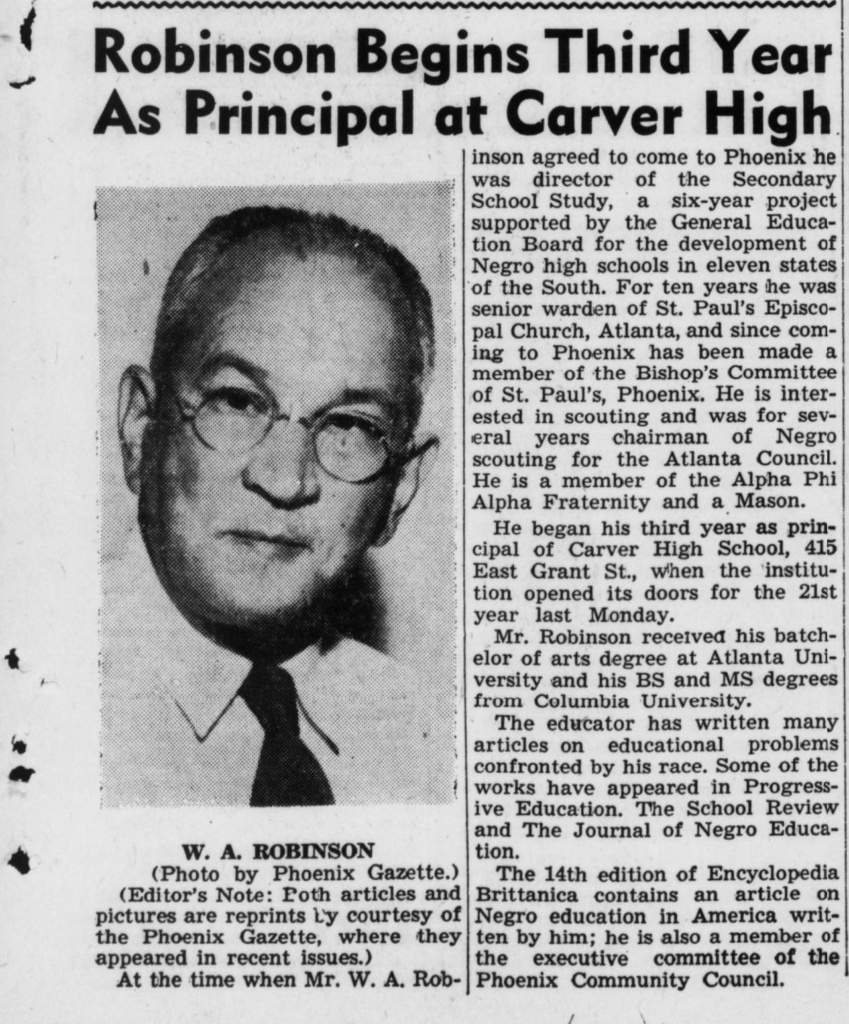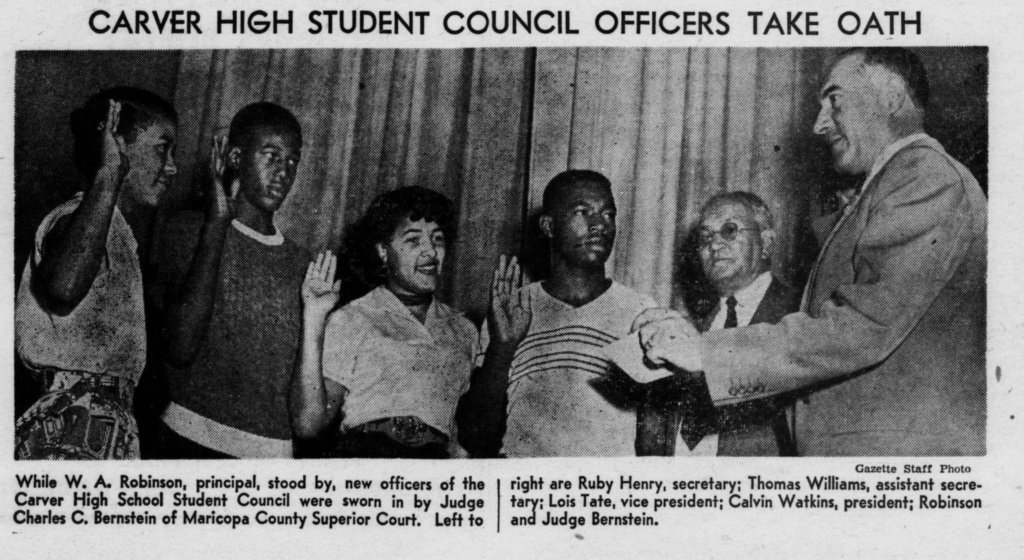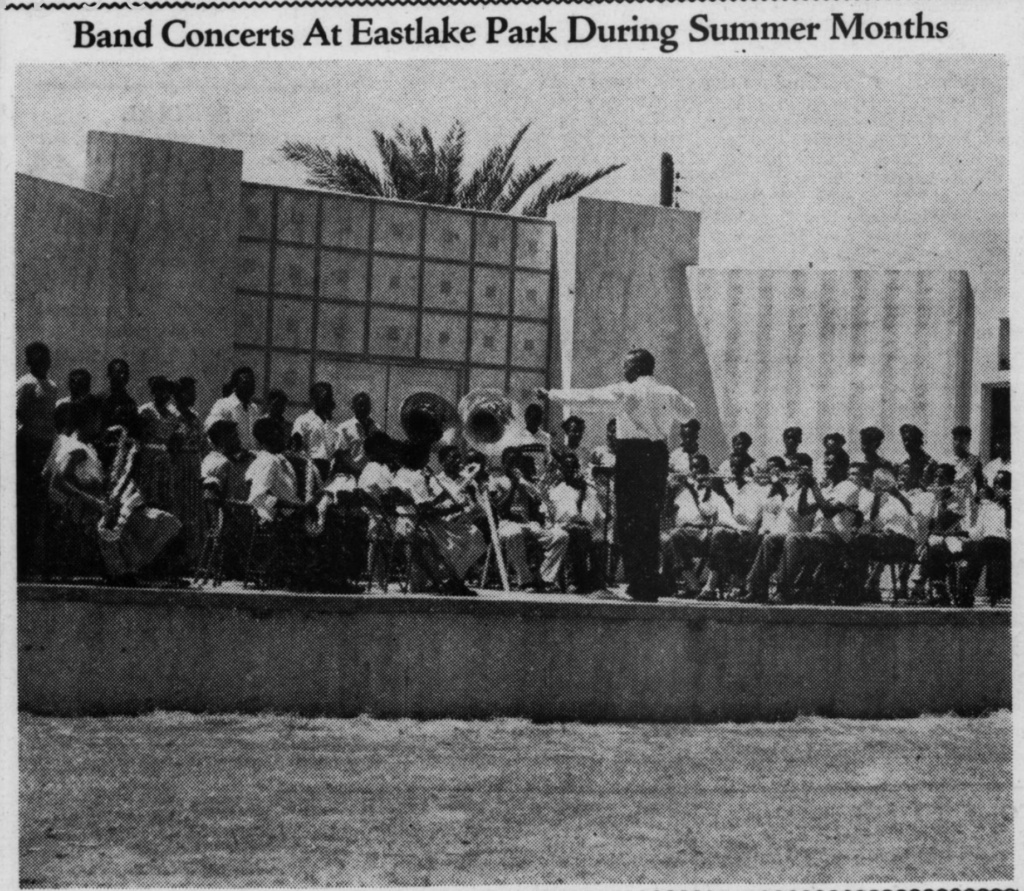Our School


The Carver Museum, Photo taken by P.A. Taliercio, May 8, 2020
“Constructed in 1926, George Washington Carver High School is exceptionally significant for its role in African American history in Arizona.
It was the only high school in the state built explicitly for the segregation of African Americans.
Although segregated high schools were not mandated by state law, Carver High School was constructed due to local sentiment, which urged racial separation among high school students.
Carver High School strived to provide a robust academic environment and produced several notable graduates, ultimately becoming a source of pride for the African American community in Phoenix.
This building is one of the few remaining structures built for African-Americans during enforced segregation from 1912 to 1954.” (1)
(1) Writer K. Weight, City of Phoenix Report, Z-72-16-8
The Formation of PUCHS/GWCHS

“New Teacher Added to Teaching Staff Colored High School”, The Phoenix Tribune, September 15, 1923

“High School Opens”, The Phoenix Tribune, Sept 17, 1920
“In 1895, Arizona’s Territorial Legislature passed a law stating that high schools could be formed in districts with a minimum of 2,000 residents. Many residents of Phoenix jumped at the chance to form a new high school. In September of that year, the high school class met for the first time on the second floor of the Central elementary school building with approximately 90 students. It is unknown whether any of these students were African American.
By 1897, it was evident that the Central building was inadequate to serve as both an elementary and a high school. That year voters passed a bond to purchase the Churchill mansion at 5th and Van Buren Streets and convert it to Phoenix Union High School. The building was enlarged and remodeled in 1899.
In 1910, Phoenix residents approved a $150,000 bond to start the Phoenix Union High School complex due to an increase in population.
In 1913, Elizabeth Harris, the first recorded African American student, graduated from Phoenix Union High School. As more African American students attended classes at Phoenix Union, a separate black high school was proposed.
When Arizona achieved statehood in 1912, only two laws addressed the question of segregation.
One of these laws prevented “intermarriage between persons of Caucasian blood and their descendants with Negroes.”
The other law provided for the establishment of segregated elementary schools.
By 1925, Phoenix had three black elementary schools—Dunbar, Frederick Douglass, and Booker T. Washington.
Phoenix was not required to build a separate black high school and did not for several years. After anti-African American sentiment increased following World War I, it was deemed necessary to separate black and white high school students.
In 1918, the “Department for Colored Students,” later known as the Phoenix Union Colored High School, was established.” (1)
(1) Writer K. Weight, City of Phoenix Report, Z-72-16-8
The Department of Colored Student & Phoenix Union Colored High School

Students learning in the library in 1933, Arizona State Library

“Commencement of Colored P.U.H.S.”, Arizona Republic, May 29, 1920
“This school had only one teacher—Mrs. C.B. Caldwell—and was housed in a rear room of the Commercial building. As separatist sentiments in Phoenix became more pronounced and African American enrollment increased, these students were sequestered into two small cottages separated from the main campus by an irrigation ditch.
In 1923, the school board appropriated $125 a month to rent a house for the black students on the corner of 9th and Jefferson Streets. The following year, the state legislature passed a special provision that allowed Phoenix to pay for a separate black high school.
On August 3, 1925, the school board commissioned the architectural firm of Fitzhugh & Bryon to prepare plans for the new building. On August 18, 1925, the school board passed a resolution that allowed for the purchase of a 5-acre site at 415 East Grant Street for $10,500.
The African American community protested the selection of this site at a community meeting on August 28, 1925. Their adopted resolution stated the site was undesirable because it was
“bounded on the north and east sides by a growing industrial district.”
“The high school board has admitted that the site is of such location that it will require the services of a watchman to protect children going to and from school.”
“The district just south of the proposed site is admitted by physicians to be a hotbed and nucleus of virulent contagious diseases to which we do not want our children exposed.”
Despite the protests, the site acquisition moved forward, and on December 21, 1925, general contractors Pierson & Johnson, who had submitted a bid of $110,000, were awarded the construction contract. Phoenix Union Colored High School, the only structure in Arizona’s history built to be as a black high school, was dedicated on September 13, 1926, and opened for classes the next day.” (1)
(1) Writer K. Weight, City of Phoenix Report, Z-72-16-8
The Educators at PUCHS
“In succession, Mrs. C.B. Caldwell, Millard T. Woods, Roy A. Lee, and W. A. Robinson served as principals of the school. All were well-qualified administrators who helped make Carver High School an excellent educational institution. In particular, Principal Robinson traveled throughout the United States recruiting instructors with master’s degrees, well before an M.A. was required.
These outstanding teachers included Arlena Seneca, Gussie Wilson, Mattie Hackett Moore, Alice Marriot, Bettye Fairfax, Deloris Adkins, Thelma Shaw, and Estelle Burnette. Educators like Arlena Seneca — a science teacher — also became active in the community. Seneca founded Careers for Youth, restarted the Urban League Guild (the women’s auxiliary for the Phoenix Urban League), and joined other professional and activist groups. In 1967, she became the first African American woman to receive the Phoenix Woman of the Year award.
In 1948, under Principal Robinson’s leadership, Carver received much-needed remodeling and enlargement. This included the construction of new shop facilities and a new 1,000-seat stadium. While Robinson’s energetic leadership was vital, the renovations were also completed because Phoenix’s white community acknowledged that the school needed improvements to remain open and maintain segregation.” (1)
(1) Writer K. Weight, City of Phoenix Report, Z-72-16-8

W.A. Robinson, Principal of PUCHS, Phoenix Gazette, September 12, 1947

Dr. Eugene Grigsby Jr., Carver High School Art Instructor, The Carver Museum Archives, 1940-1950
Student Acheivements at PUCHS
”Despite the deficiencies of Carver’s facilities, students were able to acquire quality education. Many graduates of the school have held professional and management positions. Carver graduates include Doug Nelson, Assistant Chief of Police for Phoenix; Travis Williams, City of Phoenix Human Resources Director; Dr. William Maxwell, President of Fresno Community College; Dr. Morrison F. Warren, Phoenix City Councilman, and Professor at Arizona State University; Hadie Redd, Assistant District Attorney in San Francisco; and Calvin C. Goode, the longest-serving City Council member in Phoenix history.
Carver High School had a high profile in the African American community. The faculty’s determination to provide a quality education instilled pride within the community. Carver’s auditorium was Phoenix’s largest public facility that housed black activities. Sporting events, plays, lectures, and other social events were held there. During the Great Depression, Carver provided adult evening school to retrain out-of-work black Phoenicians. Carver also turned out quality athletic teams and concert bands.
In the late 1940s and early 1950s, Carver’s football, basketball, and track teams all won state championships.
In 1952, Leon Jordan was nominated for Arizona Basketball Coach of the Year. In both 1952 and 1954, A.H. Shaw was nominated for Arizona Football Coach of the Year. In 1949, Carver’s concert band was noted for its excellence and won the statewide trophy in the Phoenix Jaycee Rodeo.” (1)
(1) Writer K. Weight, City of Phoenix Report, Z-72-16-8

“Record Class To Graduate At Carver”, Arizona Sun, June 2, 1950

Carver High School Student Training Car, Arizona Sun, November 27, 1948

“Carver Plans Homecoming”, Arizona Sun, November 18, 1949

“Carver High Student Council Officer Take Oath”, Arizona Sun, October 12, 1950

“Band Concerts At Eastlake Park During Summer Months”,

“Monarchs” Boys Baseball, The Carver Museum Archives

“Monarchs” Girls Baseball, Arizona Sun, November 19, 1949

“Sweet Sixteen Celebration”, Arizona Sun, March 16, 1951
Desegregation in Arizona
“In 1952, the interracial team of Herb Finn and Hayzel B. Daniels filed a suit (Phillips vs. Phoenix Union High School District) in Maricopa County Superior Court against the Phoenix Union High School District Board.
Phillips vs. Phoenix Union High School District was filed on behalf of three African American students who attempted to register at Phoenix Union High School.
On February 9, 1953, Superior Court Judge Fred C. Struckmeyer Jr. declared segregation in Phoenix high schools was unconstitutional, noting that “democracy rejects any theory of second class citizenship” and that “a half-century of intolerance is enough.”
Finn and Daniels attacked the issue again, focusing on elementary schools. That same year, they filed suit against the Wilson Elementary School District. In 1954, three months before the U.S. Supreme Court ruling in Brown vs. Board of Education, Superior Court Judge Charles Bernstein desegregated local elementary schools.” (1)
(1) Writer K. Weight, City of Phoenix Report, Z-72-16-8

“Segregation Unconstitutional In Arizona’s School System”, Arizona Sun, February 13, 1953

“Arizona’s Segregated School Law Repealed”, Arizona Sun, March 16, 1951
The Last Days of PUCHS/GWCHS
“With these achievements, Carver High School closed its doors in 1954, and the historically African American grade schools integrated, primarily with Hispanic children.
With mixed emotions, the students and community members watched as Carver High School closed its doors. While they mourned the loss of a nurturing and academically challenging environment, they were pleased that this chapter in racial inequality was over.
Phoenix Union, Carl Hayden, and South Mountain High Schools took on the bulk of the African American students.
In 1954, all 22 teachers from Carver were reassigned to different high schools. Principal Robinson took on a new job in administration for the Phoenix Union High School District.” (1)
(1) Writer K. Weight, City of Phoenix Report, Z-72-16-8

“66 Carver Graduates in Final Commencement Exercises”, Arizona Sun, June 4, 1954

“School Board Submits Desegregation Plan”, Arizona Sun, December 7, 1961
The Evolution
“Carver High School was converted to office space and storage for the Phoenix Union High School District. From 1956 to 1960, several of the old classrooms were partitioned to increase the number of offices. The auditorium was modified to increase its storage capacity, and the main entrance was modified from a double door to a single door entrance. The grounds behind the school were converted from athletic fields and open space to storage and maintenance structures for the Phoenix Union School District.
On March 15, 1996, the Phoenix Monarchs Alumni Association purchased the facility from the Phoenix Union High School District for $200,000.
They established the George Washington Carver Museum and Cultural Center and listed the building on the Phoenix Historic Property Register and National Register of Historic Places.
The property was also the recipient of a “Save America’s Treasures” grant in August 2008 administered by the National Park Service.
Presently situated on the site are the primary school and shop building, grandstand, and two temporary metal-framed buildings formerly used by Phoenix Union High District and now being utilized by tenants. The former athletic field has been paved over, but the grandstand remains.”(1)
(1) Writer K. Weight, City of Phoenix Report, Z-72-16-8

The George Washington Carver Museum and Cultural Center, Photo taken by P.A. Taliercio, May 8, 2020

School Sports Uniforms, Negro Baseball League Exhibit, Photo taken by P.A. Taliercio, May 8, 2020




